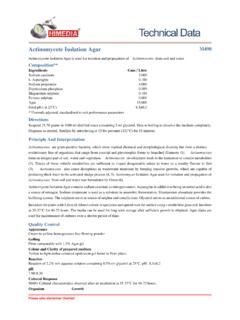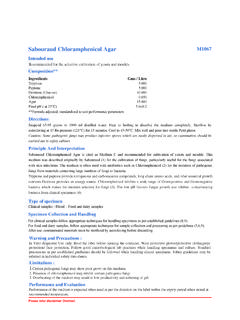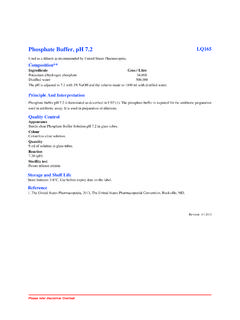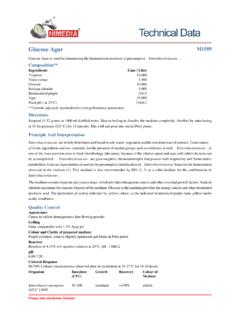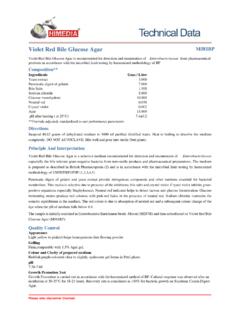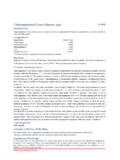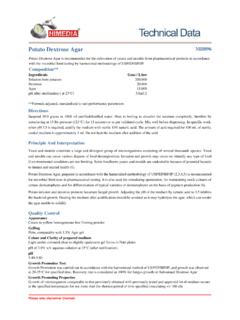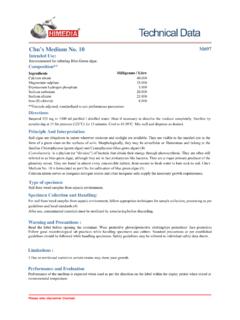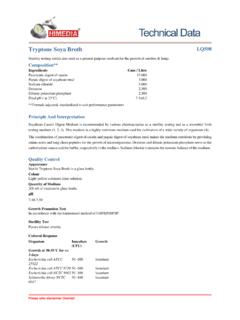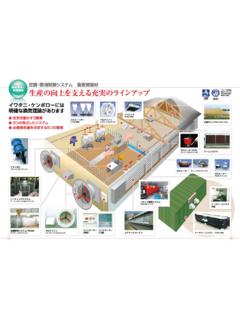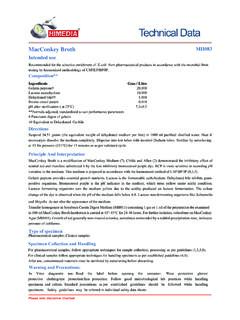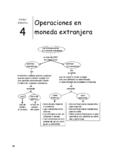Transcription of Mueller Kauffman Tetrathionate Novobiocin Broth …
1 Please refer disclaimer **IngredientsGms / LitreHM extract# ### ## thiosulphate, pH ( at 25 C) **Formula adjusted, standardized to suit performance parameters # Equivalent to Meat extract ## Equivalent to Ox bile ### Equivalent to Enzymatic digest of caseinDirectionsSuspend grams (equivalent weight of dehydrated medium per litre) in 1000 ml purified/ distilled water. Heat the medium just to boiling. DO NOT AUTOCLAVE. Cool to 45-50 C and just before use aseptically add rehydrated contents of 1 vial of MKTT Novobiocin Supplement (FD203) and 20 ml of iodine-iodide solution (20 gram iodine and 25 gram potassium iodide in 100 ml sterile distilled water).
2 Mix well to disperse calcium carbonate uniformly before dispensing in sterile : Due to presence of calcium carbonate, the prepared media forms opalescent solution with white And InterpretationThe examination of various types of food products for Salmonella requires methods different from those used in clinical laboratories. The need for such method is due to the generally low numbers of Salmonellae in foods and the frequently poor physiological state of these pathogens following exposure to stressful conditions during food processing or storage. Injured Salmonella are resuscitated in non-selective Broth medium, which facilitates detection of sublethally injured Salmonella.
3 The ideal pre-enrichment Broth should provide for the repair of cell damage, dilute toxic or inhibitory substances and nutritive enough to favour growth of Salmonella. Mueller (8) recommended Tetrathionate Broth as a selective medium for the isolation of Salmonella. Kauffman (6) modified the formula to include ox bile and brilliant green as selective agents to suppress bacteria such as Proteus species. The British Standard Specification specifies Brilliant Green Tetrathionate Broth for isolating Salmonella from meat and meat products Mueller Kauffman Tetrathionate Novobiocin Broth base Intended Use:Recommended for improved enrichment and isolation of composition and performance crieria of this media are as per the specification laid down in ISO 6579-1 / LitreMeat digest of bile for bacteriological chloride (NaCl) carbonate (CaCO3) thiosulphate, pentahydrate(Na2S2O35H2O) pH ( at 25 C) 6579-1 Specification - Muller-Kauffmann Tetrathionate - Novobiocin (MKTTn) brothM1496I - Mueller Kauffman Tetrathionate Novobiocin Broth base Supplements to be added after autoclaving / Litre 1 vial / Litre FD203 Novobiocin sodium saltIodine-iodide solution $IodinePotassium iodide (KI)
4 SolutionIodinePotassium iodide (KI) $ To be added but not provided (To be freshly prepared)HiMedia LaboratoriesTechnical DataPlease refer disclaimer from poultry and poultry products (7). It is also a recommended selective Broth for isolating Salmonella from animal feces and sewage-polluted water (9). Selectivity is conferred by Tetrathionate (from the reaction of thiosulphate and iodine). Using more than one selective Broth increases the isolation of Salmonella from samples with multiple serotypes (2). Mueller Kauffman Tetrathionate Novobiocin Broth base contains Tryptone and HM extract as sources of carbon, nitrogen, vitamins and minerals.
5 Bile and added brilliant green are selective agents, which inhibit gram-positive and other gram-negative organisms. Calcium carbonate is the buffer. Sodium chloride maintains osmotic equilibrium. Sodium thiosulphate is a source of sulfur. The Tetrathionate (S4O6) anions constitute the principle selective agent in these enrichment media. Organisms other than Salmonellae, such as Morganella morganii and some Enterobacteriaceae may grow in the , confirmatory tests should be carried out on all presumptive Salmonella colonies that are (3): The test specimen is added to Buffered Peptone Water (M1494I) and incubated at 34-36 C for 16-20 hours.
6 This pre-enriched Buffered peptone water culture is inoculated into RVSM Broth or MSRV medium and Mueller Kauffman Tetrathionate Novobiocin Broth base (M1496I) along with 20 ml of iodine solution (20 gram iodine and 25 gram potassium iodide in 100 ml sterile distilled water) and rehydrated contents of 1 vial of MKTT Novobiocin Supplement (FD203) and incubated at 37 C 1 C for 24 3 hours and further subcultured on XLD Agar (M031I) and Brilliant Agar w/ Phosphates (M016) or Bismuth sulphite Agar (M027). Further confirmation is carried out by isolation and biochemicals. Type of specimen Food samplesSpecimen Collection and Handling: For food, milk and millk products, animal feed, environmental samples, follow appropriate techniques for sample collection and processing as per guidelines (3).
7 After use, contaminated materials must be sterilized by autoclaving before discarding. Limitations complete medium is unstable and should be used immediately. After incubation, it is permissible to store theselective enrichment meidum at 5 C for a maximum of 72 pH may drop during storage due to chemical reactions. Do not use the complete medium if the pH drops below 7, and EvaluationPerformance of the medium is expected when used as per the direction on the label within the expiry period when stored at recommended Control AppearanceCream to greenish yellow homogeneous free flowing powderColour and Clarity of prepared mediumLight green coloured opalescent solution forms with heavy white precipitateReactionReaction of w/v aqueous solution at 25 C.
8 PH : ResponseCultural characteristics observed with added 20ml iodine solution and MKTT Novobiocin Supplement (FD203) after an incubation at 37 1 C for 24 3 hours. Further subculture is carried out on XLD Agar, Modified (M031I) and incubated at 37 1 C for 24 3 tests should be carried out on all presumptive Salmonella colonies that are DataStorage and Shelf LifeStore between 10-30 C in a tightly closed container and the prepared medium at 2-8 C. Use before expiry date on the label. On opening, product should be properly stored dry, after tightly capping the bottle in order to prevent lump formation due to the hygroscopic nature of the product.
9 Improper storage of the product may lead to lump formation. Store in dry ventilated area protected from extremes of temperature and sources of ignition. Seal the container tightly after use. Use before expiry date on the performance is best if used within stated expiry period. HiMedia Laboratories Salmonella Typhimurium ATCC 14028 (00031*)+ Esccherichia coli ATCC 25922 (00013*) + Pseudomonas aeruginosa ATCC 27853 (00025*)50-100red colonies w/black centre>10 colonies >104>104 Please refer disclaimer [ Salmonella Enteritidis ATCC 13076 (00030*)+ Esccherichia coli ATCC 8739 (00012*) + Pseudomonas aeruginosa ATCC 27853 (00025*)50-100red colonies w/black centre>10 colonies >104>104 OrganismInoculum(CFU)Colour of colony on XLD Agar Recovery on XLD Agar(M031I)(M031I)GrowthEscherichia coli ATCC 8739 (00012*)partial inhbition<=100 colonies on Tryptone Soya Agar Escherichia coli ATCC25922 (00013*)]
10 Partial inhbition<=100 colonies on Tryptone Soya AgarSelectivityCultural characteristics observed after an incubation at 1 C for 24 3 hours. Further subculture is carried out on Tryptone Soya Agar (M290)and incubated at 37 1 C for 24 3 hours.>104>104* - Corresponding WDCM NumbersEnterococcus faecalis ATCC 29212(00087*)inhbition - partial inhibition<10 colonies on Tryptone Soya AgarEnterococcus faecalis ATCC 19433 (00009*)inhbition - partial inhibition<10 colonies on Tryptone Soya Agar>104>104 User must ensure safe disposal by autoclaving and/or incineration of used or unusable preparations of this product. Follow established laboratory procedures in disposing of infectious materials and material that comes into contact with sample must be decontaminated and disposed of in accordance with current laboratory techniques (3,4).
